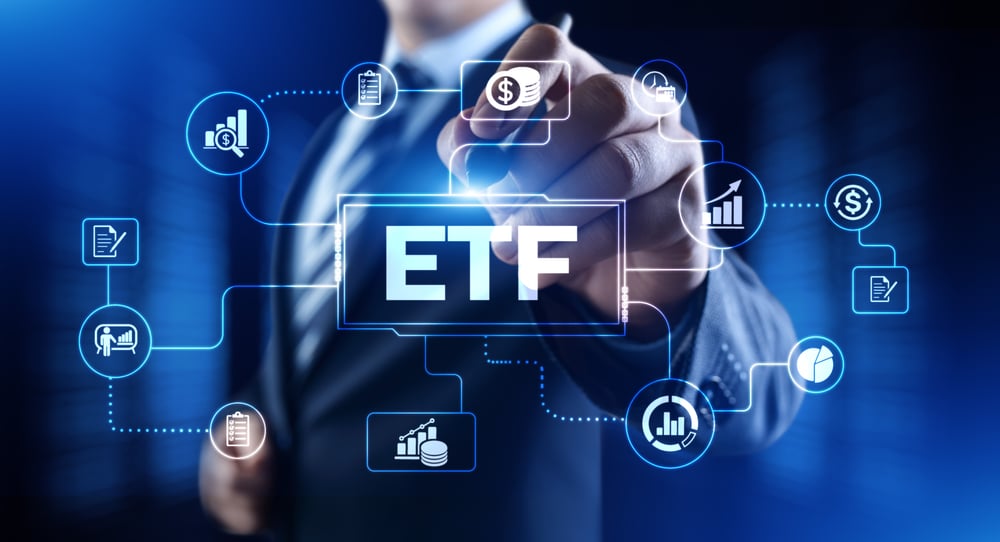
The best all-in-one ETFs in Canada
SWKStock / Shutterstock
Updated: August 17, 2023
What is the best all-in-one ETF in Canada? An investing expert examines the options and lists the best all-in-one ETF. Yes, the Vanguard all-in-one ETF made the list!
One of the most confusing aspects of becoming a do-it-yourself investor is deciding on which investment products to select to build your portfolio. With more than 900 ETFs to choose from in Canada, it can feel overwhelming — kind of like standing at the Mandarin buffet when you’re hungry. Where do you even start?
To help make it easier for you to pick the right mix of funds, ETF providers have launched all-in-one ETFs designed to be a single-ticket solution for DIY investors. Vanguard, iShares, BMO, Horizons, and TD all offer these all-in-one ETFs – often called asset allocation ETFs – in various flavours depending on your risk tolerance.
This article will look at the asset allocation ETFs offered by five ETF providers in Canada and help you pick the best all-in-one ETF.
What is an all-in-one ETF?
For decades, the balanced mutual fund was seen as an essential building block for any investor’s portfolio. More recently we’ve seen the launch of balanced ETFs, or all-in-one ETFs, as a modern and lower-cost investing option for Canadians. The point of investing in a balanced fund is simplicity — to bundle a bunch of diversified investments into one automatically rebalanced and risk-appropriate fund.
All-in-one ETFs are an absolute game-changer for DIY investors. Known as a “fund of funds,” all-in-one ETFs typically contain between four to eight underlying ETFs, and pool these stocks and bonds from around the world into one simple, automatically rebalancing investing solution. These funds are the ETF equivalent of the traditional balanced mutual fund, which are widely popular in Canada.
If you want to become a successful self-directed index investor, your first stop should be all-in-one ETFs.
Read more: ETF investing 101: an introduction to exchange traded funds
Choosing the right asset mix
Before looking at the different families of asset allocation ETFs, start by deciding the appropriate mix between stocks and bonds.
Some questions to ask yourself:
- When do you need the money?
- What would you do with your investments if stocks ever lost 20% of their value again, as they did in March 2020?
- Would you rather keep investments with fewer ups and downs but lower expected returns or slightly riskier investments that may come with bigger returns down the line?
- How stable are your current and future income sources?
- How experienced are you when it comes to investing in stocks and bonds?
You can take this more detailed risk assessment quiz from Vanguard to determine your risk tolerance.

Comparing the best all-in-one ETFs
Armed with your risk assessment, you can now start comparing the different all-in-one ETFs to see which one best suits you. Let’s look at the asset allocation ETFs offered by Vanguard, iShares, BMO, Horizons, and TD.
Vanguard all-in-one ETFs
Vanguard was first to the Canadian market with the launch of its suite of asset allocation ETFs. There are five in total, ranging from conservative to aggressive.
Vanguard’s all-in-one ETFs contain seven underlying ETFs (just four ETFs for the 100% equity version). They include :
- Vanguard Canadian Aggregate Bond Index ETF – VAB
- Vanguard U.S. Aggregate Bond Index ETF (CAD-hedged) – VBU
- Vanguard Global ex-U.S. Aggregate Bond Index ETF (CAD-hedged) – VBG
- Vanguard FTSE Canada All Cap Index ETF – VCN
- Vanguard U.S. Total Market Index ETF – VUN
- Vanguard FTSE Developed All Cap ex North America Index ETF – VIU
- Vanguard FTSE Emerging Markets All Cap Index ETF – VEE
Geographically, Vanguard allocates 30% of the stock component to Canadian equities, 42% to US equities, 20% to international (developed) equities, and 8% to emerging market equities.
iShares All-in-One ETFs
iShares is the largest ETF provider in Canada, and they were next to launch their series of asset allocation ETFs, with names and ticker symbols closely mirroring the Vanguard products.
The iShares all-in-one ETFs each contain eight individual ETFs, except for XEQT which includes four equity ETFs and no bonds. These underlying ETFs include:
- iShares Core Canadian ST Corp + Maple Bond Index ETF – XSH
- iShares Core Canadian Universe Bond Index ETF – XBB
- iShares U.S. Treasury Bond ETF (CAD-hedged) – GOVT
- iShares Broad USD IG Corporate Bond ETF (CAD-hedged) – USIG
- iShares Core S&P/TSX Capped Composite Index ETF – XIC
- iShares Core S&P Total U.S. Stock Market ETF – ITOT
- iShares Core MSCI EAFE IMI Index ETF – XEF
- iShares Core MSCI Emerging Markets ETF – IEMG
The geographic allocation includes 25% Canadian equities, 45% US equities, 25% international equities, and 5% emerging market equities.
BMO All-in-One ETFs
Not to be outdone, BMO Asset Management also offers its own asset allocation ETFs with a small suite of three products:
Under the hood, these funds of funds include seven individual BMO ETFs:
- BMO Aggregate Bond Index ETF – ZAG
- BMO Government Bond Index ETF – ZGB
- BMO Mid-Term US IG Corporate Bond Hedged to CAD Index ETF – ZMU
- BMO S&P/TSX Capped Composite Index ETF – ZCN
- BMO S&P 500 Index ETF – ZSP
- BMO MSCI EAFE Index ETF – ZEA
- BMO MSCI Emerging Markets Index ETF – ZEM
BMO’s asset allocation ETFs allocate 25% of their equities to Canada, 40% of their equities to the US, 25% to international markets, and 10% to emerging markets.
Horizons all-in-one ETFs
What sets Horizons’ suite of all-in-one ETFs apart is that they’re structured as something called a total return swap. A typical ETF will distribute dividends and interest to investors throughout the year. With Horizons’ all-in-one ETFs, investors won’t receive any income from the ETF. Instead, these investors will only incur capital gains when they sell. This structure can be advantageous when held in a non-registered (taxable) account if you don’t want to receive taxable investment income (say in high-income earning years).
With that important preamble out of the way, here’s a look at Horizons all-in-one ETFs:
The Horizons all-in-one funds contain eight individual ETFs, except for HGRO which holds six underlying ETFs (no bonds).
- Horizons CDN Select Universe ETF
- Horizons US Large Cap Index ETF
- Horizons US 7-10 Year Treasury ETF
- Horizons NASDAQ-100 Index ETF
- Horizons INTL Developed Markets ETF
- Horizons Europe 50 Index ETF
- Horizons Emerging Markets ETF
That breaks down to 55% of its equity holdings to US stocks (large-cap index plus NASDAQ), 16% to Canadian stocks, 14% to international (developed) market stocks, 7% to European stocks, and 7% to emerging market stocks.
TD all-in-one ETFs
TD has also launched an asset allocation series they call their One-Click ETF portfolios. These all-on-one ETFs differ from their competitors because they contain a mix of passive and actively managed funds.
The One-Click portfolios contain the largest underlying holdings of the bunch. 75% of the holdings are passively managed while the remaining 25% are actively managed.
Passive holdings:
- TD Canadian Aggregate Bond Index ETF – TDB
- TD U.S. Long Term Treasury Bond ETF – TULB
- TD Canadian Long Term Federal Bond ETF – TCLB
- TD Canadian Equity Index ETF – TTP
- TD U.S. Equity Index ETF – TPU
- TD International Equity Index ETF – TPE
- TD Global Technology Leaders Index ETF – TEC
Active holdings:
- TD Active Global Income ETF – TGFI
- TD Select Short Term Corporate Bond Ladder ETF – TCSB
- TD Active U.S. High Yield Bond ETF – TUHY
- TD Q Global Dividend ETF – TQGD
- TD Q Canadian Low Volatility ETF – TCLV
- TD Active Global Equity Growth ETF – TGGR
- TD Q U.S. Small-Mid Cap Equity ETF – TQSM
TD allocates around 33% of its equities to Canadian stocks, 44% to US stocks, and 23% to international stocks.
What is the best all-in-one ETF?
DIY investors cannot go wrong by choosing a risk-appropriate asset allocation ETF from either Vanguard, iShares, or BMO. These three ETF providers offer the best all-in-one ETFs in Canada, with only slight differences between the three suites of products.
- Vanguard’s all-in-one ETFs are best for investors who want a higher allocation to Canadian stocks. This allocation is good for Canadian retirees who spend Canadian dollars and want to reduce the impact of foreign currency on their investment portfolio.
- iShares’ all in one ETFs are tied for the least expensive in Canada and have a higher exposure to US equities (and less exposure to Canadian stocks). This allocation is good for investors who believe the US stock market will continue to outperform Canadian stocks.
- BMO’s asset allocation ETFs are also tied for the least expensive in Canada. They’re also known for their solid fixed income ETF options that you’ll find under the hood of their all- in-one ETFs. However, they don’t offer an all-equity version or an ultra-conservative version. This allocation is good for investors who prefer more emerging market stock exposure.
- Horizons’ unique total return swap ETFs are worth a look in a taxable account – especially for investors who are in a high tax bracket and do not want to receive dividend or interest income. Beware, though, these all-in-one ETFs are not as diversified as the Vanguard, iShares, or BMO options and come with some regulatory risk if a future government disallows the swap-based structure. The structure is not appropriate inside a registered (RRSP, TFSA) account.
- TD’s One-Click ETFs are a good option for TD clients, particularly the ones who invest using the TD GoalAssist app where they can purchase the ETFs for free. These ETFs do have an active management component, though, so pure index investors may want to avoid them.
The verdict
After careful analysis comparing the five families of all in one ETFs, I’ve declared iShares to be the winner.
The iShares asset allocation suite of XINC, XCNS, XBAL, XGRO, and XEQT are all solid choices with terrific underlying ETF holdings and are the least expensive all-in-one ETFs on the market.
Investors can purchase iShares’ all-in-one ETFs for free at Questrade, Wealthsimple Trade, BMO InvestorLine Self-Directed, and Scotia iTrade (XBAL and XGRO only). If you’re not sure which online brokerage to go with, check out this head-to-head comparison of the best online brokerages in Canada.
Read more: Best online brokerage accounts in Canada for 2023

Robb Engen is a leading expert in the personal finance realm of Canada and is also the co-founder of Boomer & Echo, an award-winning personal finance blog.
Disclaimer
The content provided on Money.ca is information to help users become financially literate. It is neither tax nor legal advice, is not intended to be relied upon as a forecast, research or investment advice, and is not a recommendation, offer or solicitation to buy or sell any securities or to adopt any investment strategy. Tax, investment and all other decisions should be made, as appropriate, only with guidance from a qualified professional. We make no representation or warranty of any kind, either express or implied, with respect to the data provided, the timeliness thereof, the results to be obtained by the use thereof or any other matter. Advertisers are not responsible for the content of this site, including any editorials or reviews that may appear on this site. For complete and current information on any advertiser product, please visit their website.





